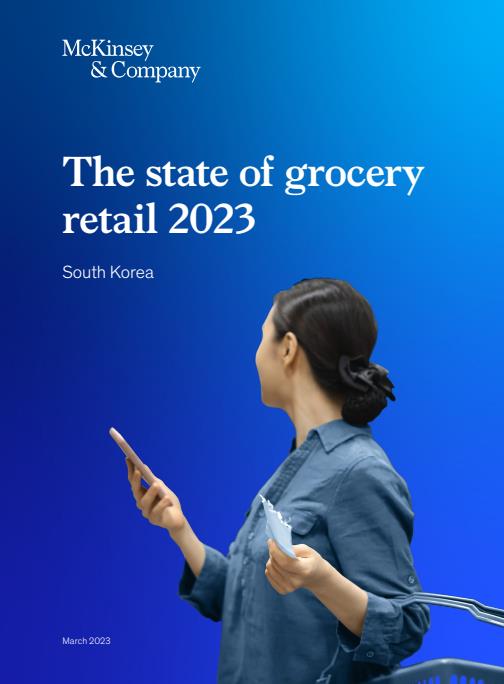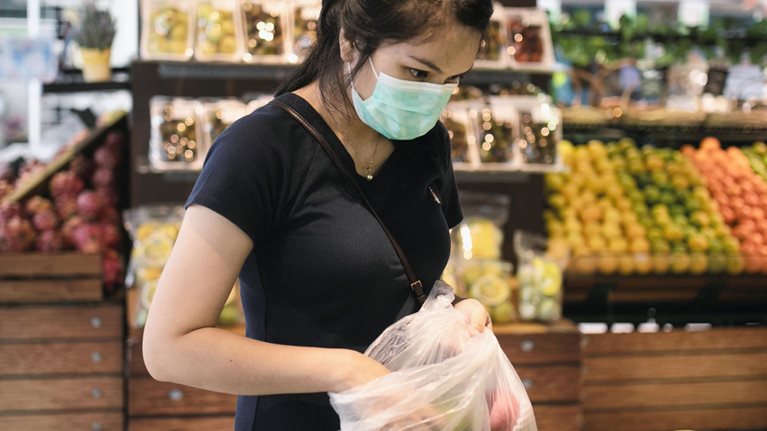Over the past five years, disruptive forces have reshaped retail grocery in South Korea. Demographic patterns, including the rise of single-person households and the embrace of mobile channels by elderly shoppers, have implications for physical stores and digital commerce alike. Rising competition from e-commerce players has forced traditional grocery retailers to elevate their online game. And the pandemic further changed consumer preferences—not just fostering an embrace of online channels but also increasing the popularity of convenience stores.
Executives have become adept at responding to a shifting landscape. So what lies ahead? Our research, analysis, and work with clients suggest five trends will have an outsize impact on the grocery market in the coming year.
Eating behavior: South Koreans want convenience
South Korean consumers are increasingly shifting from cooking from scratch to eating out or more conveniently. What does “convenience” mean? According to our 2021 South Korea grocery survey,1 45 percent of consumers prefer prepackaged and partially cooked fresh meals that require some preparation (compared with 34 percent of the world), and 41 percent order prepared foods for delivery (versus 24 percent of the world).
The home meal replacement (HMR) market was expected to reach about 5 trillion won ($4.3 billion) in 2022, up twofold from five years ago.2 Both start-ups and large food and beverage companies are competing fiercely in this growing market; this is especially apparent in the meal-kit category, which barely existed five years ago. Meal kits are popular among higher-income groups and have become a premium offering. Department stores and popular offline restaurants are also developing their own meal-kit offerings.
The food delivery market has also expanded dramatically. For decades, South Korean consumers preferred to order food from restaurants by phone. This was possible because restaurants were nearby in highly populated cities; today, South Korea is one of the most urbanized countries, with 91.8 percent of its population living in cities.3 The emergence of mobile food-delivery platforms has increased food-delivery orders even more by offering a variety of food options, a convenient ordering process, and options to filter high-quality restaurants. Coupang entered this market a few years ago, an indication of its growth. Online food delivery transactions reached 25.7 trillion won in 2021, a more than ninefold increase over four years.4 It now exceeds the online food and beverage market, at 24.3 trillion won. Because the market is made up of a few dominant players, the South Korean government is keeping an eye on how it develops, and some regional governments are launching their own services. In China, the national government is pressing the large delivery players to decrease their commissions.5
Brick and mortar: Not a sinking ship for everyone
In Asia, South Korea has the highest share—86 percent—of modern grocery retail (supermarkets, hypermarkets, and discounters).6 This trajectory has been fueled by the growth of hypermarkets (25.7 trillion won in 2021) and supermarkets (25.8 trillion won). However, traditional leaders are ceding market share to upstarts that are addressing changing consumer preferences.
For example, buying groceries (especially fresh products) has been the primary reason for consumers to go to physical hypermarket stores. The share of grocery as a percentage of sales in this format continues to rise, from 56 percent in 2016 to 67 percent in 2021 (Exhibit 1). Yet this trend is not influential enough on its own to compensate for the declining share of hypermarkets in South Korea.

Meanwhile, special formats—such as convenience stores, warehouse clubs, and discounters—are experiencing sustained growth, a reflection of the increased desire among consumers to shop at a conveniently located store that has everything they need under one roof (see sidebar, “Deep dive: Consumer behavior of single-person households”).
Convenience store revenue grew more than fourfold, from $5.8 billion in 2010 to $24.7 billion in 2021,7 surpassing hypermarkets and supermarkets. The total number of stores rose to more than 49,300 in 2021, equal to one convenience store for every 1,049 people.8 Even with this increase, South Korea has already surpassed countries such as Japan, where the ratio was one convenience store for every 2,021 people in 2021. Rather than simply relying on expanding their footprint, grocers are also focusing on qualitative growth, developing unique products that can be found offline only, and adding categories such as fresh produce and wine. For instance, Emart24 sold more than three million bottles of wine in 2021.9
Warehouse clubs also continue to expand. High-income consumers and large households regularly visit this format, but small-business owners are the biggest purchasers. For these reasons, conventional retailers (such as E-Mart) are planning to increase their footprint in warehouse clubs.
Although convenience has become a higher priority for consumers, supermarkets and hypermarkets will have to do more than be located in close proximity. They should seek to rigorously develop new reasons for consumers to visit. For example, retailers have started to offer a wide range of beer and wine because most alcohol cannot be purchased online. Similarly, some hypermarkets are creating “deli corners” for cooking fresh foods (such as steak and lobster) in an attempt to draw people to the hypermarket for meals as well as shopping. Maintaining profitability will continue to be a never-ending challenge.
Online: Growth will come from the elderly population and fresh products
During the COVID-19 pandemic, online shopping increased significantly worldwide. In South Korea, it grew to more than 41 percent of total retail and approximately 24 percent in grocery.10
In South Korea, online has the potential to grow significantly in specific segments, such as elderly consumers. Just 9 percent of baby boomers indicated that Coupang, the largest e-commerce player, is their main grocery channel (compared with 19 percent of Gen Xers and 30 percent of millennials). Consumer segments that have been slow to embrace online in grocery pointed to several factors: in our survey, 39 percent of respondents cited the quality of the fresh foods, and 24 percent pointed to delivery charges, high minimum order value, and too much packaging. Among baby boomers, 26 percent report that the online selection is not large enough, and product descriptions are insufficient. Despite the current lower penetration of online shopping for this consumer segment, their online consumption gradually increased. According to a Korea Consumer Agency survey, in 2021, online consumption by elderly people (aged 60 and over) rose tenfold over the previous two years, far outpacing the overall twofold rise during this period.11
Delivery speed and low delivery costs are top priorities for most of the world, but that is not the case for South Korean consumers, who prefer next-day delivery over instant delivery. One reason could be the prevalence of convenience stores and well-developed, next-day “dawn delivery” offerings (Exhibit 2).

‘Sustainability’ is more than just a buzzword in grocery
South Korean consumers have typically expressed less interest in environmental responsibility across retail categories, but grocery is an exception. Compared with consumers in other countries, South Korean shoppers show a significantly higher willingness to pay more for environmentally friendly grocery goods that minimize the amount of packaging.12
As income levels grow and people are more focused on quality of life, they have shown a greater interest in healthy eating. What’s more, they are willing to pay higher prices to get healthier products. Grocery retailers have responded by launching new products with less sugar, fewer artificial ingredients, and additional nutrients, a move that has boosted revenues. Organic grocery retailers recorded double-digit growth in sales in fiscal year 2020, and Oasis saw a jump of 50 percent in 2021 compared with the previous year.
Packaged-food players have also worked on sustainability over the past several years. Plastic bottles without labels to facilitate recycling are just one of the more visible changes on store shelves. Meanwhile, consumers have traditionally expected food producers to maintain higher standards for quality and sustainability.
One of the primary factors preventing consumers from buying online is too much packaging used in delivery. In response, leading e-commerce retailers, such as Coupang and Market Kurly, have introduced reusable-packaging programs.
Bifurcation in spending: Searching for premium and value for money
Traditionally, premium grocery catered to a smaller share of consumers, but that base is now increasing. Lotte Department Store’s premium-grocery category grew by more than 35 percent annually over the past two years,13 and Hyundai Department Store recently started live streaming content on premium local delicacies, drawing customers primarily in their 20s and 30s.14
Consumer goods companies are pursuing strategies in the premium category to make up for declining operating profit caused by soaring prices for grains and other raw food. But not every retailer has been successful. Consumers routinely conduct significant research before they buy, and their digital literacy is higher than ever. In this market, new premium products that lack a clear value proposition have not resonated with consumers, many of whom are still actively seeking ways to save money and get the best promotions. To break through, grocers need to understand the attributes for which consumers are willing to pay more, rather than just adding fancy ingredients so they can charge higher prices.
Discounters and variety stores have also taken hold: this format grew 8 percent per year over the past five years, reaching $3 billion in 2021.15 Penny stores such as Daiso and No Brand have gained share in grocery with a value proposition that focuses on value for money and smaller units. No Brand’s sales increased at a CAGR of 32 percent from 2017 to 2021, and its food category continues to grow, especially as it expands into categories such as biscuits, canned food, and ice cream. Affluent consumers also visit penny stores, attracted by “category killer” grocery items such as snacks and HMRs.
Collectively, these trends have major implications for grocers, from their operating models and store formats to their investments in analytics and technology. Winning retailers will carefully monitor changing consumer behaviors and market patterns and respond quickly to gain an advantage.


